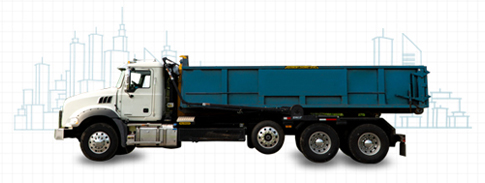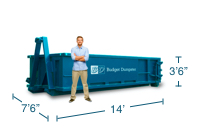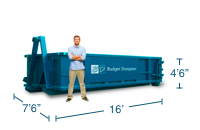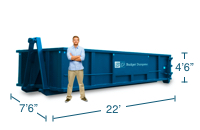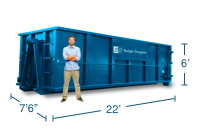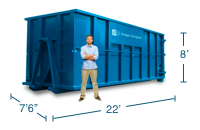
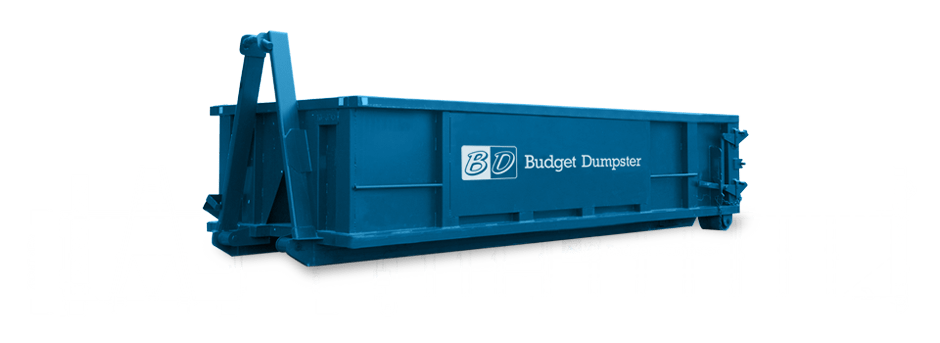
Cut Cleanup Costs With Upfront Dumpster Rental Pricing
Managing waste in San Antonio is easier with a flat-rate roll off dumpster. Delivery, pickup and your rental period are bundled into one simple price with no hidden fees or surprise charges.
With us, you'll enjoy:
- Expert support from start to finish
- Easy online ordering
- A variety of roll off container sizes
Price tags change with your zip code! Call or order online to get exact pricing.
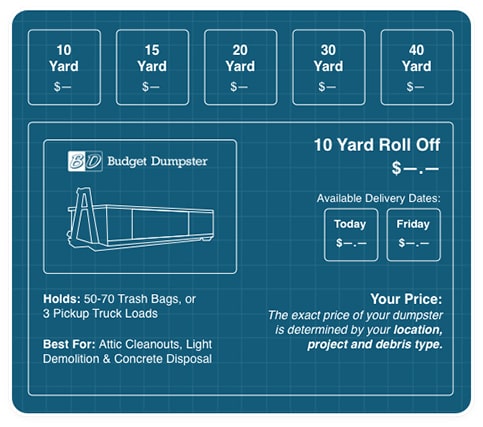
How Our Rental Process Works
1. Choose a size and delivery spot. We require 60 feet of space in a straight line and 23 feet of vertical clearance.
2. Prepare for delivery. Remove any vehicles, materials or low-hanging obstacles to ensure we can deliver your dumpster and to avoid a trip fee.
3. Fill up your dumpster. Remember to keep your included weight limit in mind to prevent overage fees.
4. Schedule your pickup. To ensure pickup and avoid a trip fee, your dumpster must be accessible and only contain approved debris piled no higher than the sidewalls.
What People Are Saying About Budget Dumpster
by Jeanette Fowlks
July 22
Budget Dumpster was great to work with
Read moreby B. Weeks
July 7
Beware upcharge
Read moreby Robert Mims
July 5
Picked up & delivered as was agreed…
Read moreRent a Dumpster in San Antonio to Stay on Schedule
From downtown jobsites near the River Walk to renovations in Stone Oak, contractors and homeowners rely on our roll off dumpster service to keep projects moving. We help you choose the right bin, deliver to your site on time and return promptly for pickup. Whether you're clearing out your home in Mahncke Park or managing demolition near the Missions, our process is built for speed and simplicity — no delays, no guesswork. Order your dumpster rental online to get started or contact us today for a custom quote.
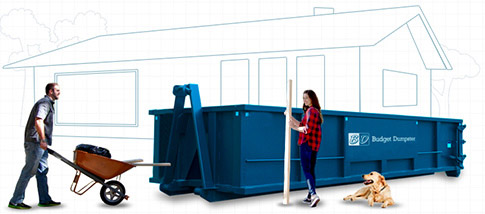
How We Support Your Project
We understand the pace and pressure of working in a city like San Antonio — that’s why we offer more than just a dumpster rental. We provide on-time deliveries and pickups to prevent delays. Plus, we never leave you hanging — you’ll get access to a Service Dashboard where you can change your delivery date or schedule a pickup.
What Materials Can Our Dumpster Rentals Take?
Accepted Household Debris
- household junk
- carpet
- flooring
- appliances
- electronics
- furniture
- mattresses & box springs
- fixtures
- yard waste
- stumps
Accepted Construction and Heavy Debris
- construction debris
- wood & drywall
- roofing materials
- concrete
- block
- brick
- asphalt
*Please call your sales representative to learn more about disposing of specific materials, as well as any items we cannot accept.
Frequently Asked Questions
Do I need a permit to rent a dumpster in San Antonio?
Yes, you need a right-of-way permit before delivery if you plan to keep your dumpster rental in the street. You can apply through the city of San Antonio's Public Works Department. You usually don't need a permit to keep your bin on private property.
What neighborhoods do you service in San Antonio, TX?
We service the following neighborhoods, along with many others in the Texas Triangle. If your neighborhood isn’t listed, contact us to request service near you.
Prospect Hill, Highland Hills, People Active in Community Effort, Vance Jackson, Alamo Farmsteads - Babcock Road, South Southwest, Great Northwest, Dellview Area, Heritage, Palm Heights, Highland Park, Northwest Crossing, Stone Oak, Shearer Hills - Ridgeview, Oak Park - Northwood, Greater Harmony Hills, Los Angeles Heights - Keystone, Northwest Los Angeles Heights, Quintana Community, Thompson Community
What zip codes do you service in San Antonio?
We deliver dumpster rentals to the following San Antonio zip codes, plus many others throughout Texas. If you don’t see your zip below, reach out to our team to ask about renting a dumpster.
78015, 78023, 78073, 78109, 78112, 78154, 78201, 78202, 78203, 78204, 78205, 78206, 78207, 78208, 78209, 78210, 78211, 78212, 78213, 78214, 78215, 78216, 78217, 78218, 78219, 78220, 78221, 78222, 78223, 78224, 78225, 78226, 78227, 78228, 78229, 78230, 78231, 78232, 78233, 78234, 78235, 78236, 78237, 78238, 78239, 78240, 78241, 78242, 78243, 78244, 78245, 78247, 78248, 78249, 78250, 78251, 78252, 78253, 78254, 78255, 78256, 78257, 78258, 78259, 78260, 78261, 78263, 78264, 78266, 78284, 78285
Does hot weather impact dumpster rentals?
Yes — extreme Texas heat can affect certain materials, especially adhesives and solvents, making them difficult to dispose of safely. Keep your roll off container shaded if possible and avoid placing temperature-sensitive items in direct sunlight. Our team can help you plan around seasonal conditions.
Household & Construction Dumpsters
These roll off dumpsters can be used for common household and commercial projects, including home cleanouts, remodeling, general construction and demolition.
*Disclaimer: All dumpster dimensions may vary slightly but volume is accurate. Prices and availability are subject to change without notice. Capacity estimates are based on the volume of a 33 gallon trash bag.
Looking for a dumpster closer to home? Find your location below:
Become a Hauling Partner
Want more business? Work with us and you can sell more dumpsters without the added overhead. Learn more about partnering with Budget Dumpster.
